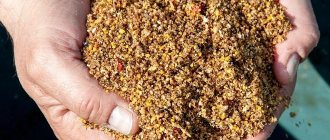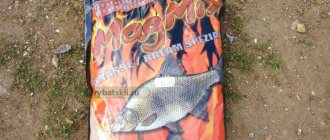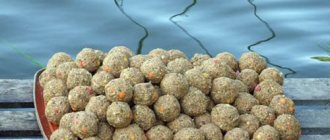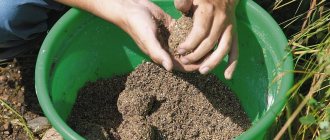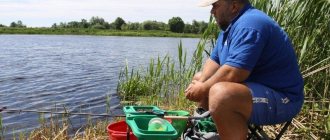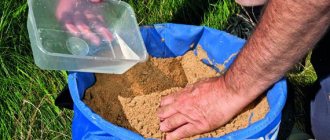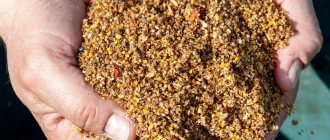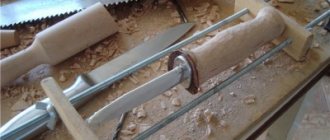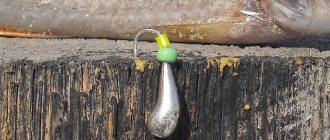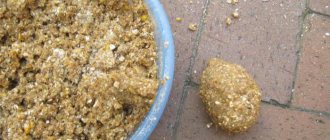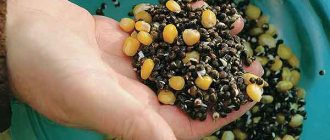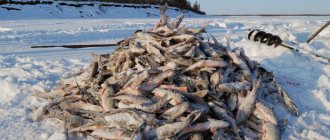Winter bait for bream is the basis for the success of ice fishing for this underwater inhabitant. It allows you to attract fish to the hole, encourage it to bite and keep it in a given zone for a long time. When catching bream from ice, various bait mixtures are used, from factory brands to homemade variations made at home from available components. What will work best is impossible to answer unequivocally. In certain situations, a certain composition works. The more experienced the fisherman, the more competently he focuses on fishing conditions and seasonal factors, and more accurately selects the feed mixture.
What you need to know about winter feed
Complementary feeding for bream in winter has certain differences from summer mixtures. This is the main factor when choosing it in a store or making it yourself at home:
- Fine grind. Such fractions ensure the formation of a thick food spot on the bottom, making it more difficult for bream to get enough.
- Low calorie content. Bream cannot be overfed, otherwise you can forget about a stable result.
- Low stickiness. Ideally, when pressed, the formed ball should easily crumble into particles, leaving no lumps.
- No odor or minimal aroma.
For ice fishing, the color of the mixture is matched to the color of the soil. The bait should contrast at the bottom, attracting the attention of the fish.
Make or buy - pros and cons
Should I buy bait mixture or make it myself at home from available ingredients? Both options have positive and negative sides. The factory mixture makes the task easier. There is no need to think about the composition, mix the components, or monitor their proportions. However, it has disadvantages:
- Cheap food is ineffective. You will have to buy an expensive premium brand that is respected by advanced breamers.
- Many commercial feeds are designed with universal properties, so they may not work at all on certain bodies of water.
- Purchased bait does not contain the main winter component – the animal. And since you still have to add it to the mixture, it is much wiser to prepare it yourself from the beginning.
We recommend reading: Do-it-yourself catchy bait for carp Homemade
bait is cheaper than store-bought bait. The fisherman gets the opportunity to independently select the components, their proportions, experiment with fraction sizes, colors, and flavors. In any case, making the mixture with your own hands is much more interesting than simply purchasing it at a fishing point.
Main ingredients and flavorings for bait
The main components for bream baits are fried sunflower seed cake , breadcrumbs and boiled millet groats. It is better to use natural ingredients as flavorings: coriander, dill, flax or hemp seeds, vanillin. According to many bream fishermen, bream responds very positively to the smell of garlic.
As additional components, you can add peas, bran, and animal ingredients. In a word, the composition is selected according to the place and time of fishing. There is also a rule that the bait must contain those components that will be used as bait.
How to make winter bait for bream with your own hands
There is no ideal composition that works all winter in different bodies of water. At home, you can prepare a mixture for any situation, be it current or standing water, a channel hole or a coastal edge, a uniform section of the bottom or with sudden changes.
Main components:
- bloodworm;
- cake;
- breadcrumbs;
- cereals;
- boiled peas.
Below are several simple but productive recipes for preparing bait for winter bream fishing.
Made from herbal ingredients
It is not surprising that for winter baits are sometimes used that consist entirely of ingredients of plant origin. Popular in our latitudes is breaded peas. For her they take:
- 0.4–0.5 kg of pea porridge;
- 0.5 kg breadcrumbs;
- 0.3 kg of crushed sunflower seeds;
- 0.2 kg of rolled oats flakes.
Combine the crackers and seeds and mix them thoroughly. Add finely granulated flakes. Boiled peas come last to adjust the consistency of the composition. Complementary foods are made dry and do not stick to your hands.
Advice! Coriander is added to bait when targeting large bream.
You can add sunflower cake and ground pumpkin seeds to the resulting mixture. Flavorings include garlic, fennel, anise, coriander.
Animal origin
The simplest bait made from live ingredients is bloodworms mixed with soil. It is enough to combine a mosquito larva with soil or clay from the bottom of a reservoir, moisten it, form balls and send them into the hole. This mixture is characterized by short range, accuracy and efficiency.
In regions where mormysh is common, it is used in bream bait. Take fresh amphipods or frozen briquettes and mix them with soil. Flour is added to give better stickiness. All that remains is to moisten the mixture with water, form balls with a diameter of 3–8 cm, and place them in the water.
Recommended reading: Catching carp with boilies
General requirements for bait
The main requirements that bait must meet are to attract fish and keep them, without allowing them to get enough.
- Aroma. Bait for bream, whatever its composition, must be aromatic, this is one of the main conditions. The choice of a specific flavor depends rather on the preferences of the fish in a given body of water and the time of year.
- Compound. The bait must necessarily include the components that make up the food base of the bream. These are all kinds of cereals. Animal components in the bait may include: bloodworms, worms and maggots.
- Large or small particles. The bait should consist mainly of small particles, but it must also contain large ones; the main thing here is to maintain the correct balance. The role of small particles is to create turbidity and attract fish, and large ones are to keep them on the feeding spot. A large number of large particles will quickly saturate the fish and they will not pay attention to your bait, and a large number of small particles will attract too many small fish.
- Binding components. These components have high adhesiveness and low nutritional value, with a weak, non-fish-repellent, or no odor at all, capable of gluing dissimilar components together. The primary task of the binding components is to increase the time of erosion of the bait in the water. Their quantity depends on the fishing conditions; in still water they are added at a minimum, in currents more. The following binder additives for bream fishing are:
- Clay.
- Pea flour.
- Millet flour.
- Hercules flakes.
Top 5 winter factory baits for catching bream
Fishing stores sell a variety of brands, and choosing the right bait from them is not easy. Experienced bream fishermen have tried many mixtures and identified the most catchy and versatile ones:
- Mondial-F Wintermix Bream Red. It smells like worms and bloodworms, is frost-resistant, and crumbles only when it reaches the bottom.
- Dunaev Bream. The food is aimed at large fish. Light yellow with red particles.
- Trapper Winter. Fine grinding, low calorie content, frost resistance, specialized lightweight aromatization.
- Sensas Ice Fishing. Universal, designed for different sizes of fish, works from the first to the last ice.
- Greenfishing Ice Bream Red. Fractions of medium size, red-red color, attract fish well from a long distance.
When buying bait mixture for fishing in winter, you need to focus on the price of the product and reviews from experienced fishermen, which are now easy to find on the Internet on various thematic platforms and on social networks.
Recipes for preparing bait for fishing at different times of the year
The time of year makes its own adjustments to the quantitative and qualitative composition of bait. In summer, bait should be less caloric, in spring and autumn, vice versa. In winter, the bait can generally be a maximum of two components without adding flavorings.
Summer bait
In the summer, bream rarely gather in schools and in order to gather them on the feeding table you need to use more bait than, for example, in the spring. In summer, the bait should contain components that will create a cloud of turbidity to attract fish.
Composition of summer bait:
- millet 1 part;
- rolled oats 1 part;
- peas 0.2 parts;
- pearl barley 0.2 parts.
Flavorings depending on the weather, it can be dill, garlic or vanilla. Millet, pearl barley and peas are boiled, rolled oats are fried and ground in a coffee grinder.
Bait for autumn
An obligatory component of autumn bait is chopped worms or bloodworms; the number of components that create turbidity must be reduced.
The composition of the autumn bait is as follows:
- breadcrumbs 1 part;
- bran 1 part;
- millet porridge 1 part;
- ground peanuts 0.5 parts;
- feed bloodworm or chopped worm 0.5 parts
Bait for spring
Spring bait is practically no different in composition from autumn bait. It also contains animal components, it must be high in calories, here is one of the recipes:
- peas, pearl barley, wheat in a sum of 500 g;
- fried rolled oats 300 g;
- millet 300 g;
- chopped worm 300 g.
Groundbait for winter
When fishing for bream from ice, you can successfully use both animal and vegetable baits, or mixtures thereof. As animal baits, nothing better than small bloodworms has yet been invented. In some places, bream are more attracted to ordinary ground crackers poured into the hole. There are special bait mixtures for sale for winter fishing, but according to the observations of many anglers, it is better to use regular breadcrumbs without any aromas or fragrances.
In winter, bream is wary of strong odors.
Groundbait based on a mixture of planing crackers and bait bloodworms performs well, and the amount of bloodworms should be minimal; its role is to attract fish with its movement at the bottom and deplete the smell.
Feeding tactics
Fishing success depends not only on well-chosen bait. Initially, you need to determine a promising point. To do this, it is necessary to study the topography of the place, to detect anomalous zones with differences in depth, where the probability of bream staying is maximum.
When the place for the upcoming fishing has been chosen, you can start feeding. There is no need to pour in a lot of mixture at once, just throw in 2-3 portions. A spot will form on the bottom that will attract bream and keep it at the feeding point.
Optimal distance between holes
Having chosen a fishing zone, drill 5-6 holes at intervals of 15-20 meters. They feed them and begin to catch them. Gradually, the fisherman identifies workers and auxiliaries. The former are used for active fishing; the latter are switched to when the bites decrease.
Lower with a feeder or sprinkle from above
In most cases, bream is caught at depth in winter. That’s why they use special dump truck feeders. This is an ordinary metal or plastic cone with an opening bottom. It is filled with food and lowered into the hole on a thick fishing line. Before reaching the bottom 20–30 cm, the lid opens with a sharp jerk, and the treat is poured out to the desired point.
It is irrational to use balls, since they will crumble in the water column. You can feed the hole using this method at medium depths and calm water.
When fishing in the current, the food is lowered into a hole drilled above the main one. The distance can vary from 0.5 to 3 meters, depending on the depth and strength of the flow. Sometimes it is advisable to use a special capacious bag. Then the stream will wash the complementary food out of it, creating an attractive trail behind it.
Recommended reading: The best bait for roaches in winter
Preparation of bait (recipes)
There are many recipes for bait for bream with all kinds of additives and flavorings, but each fisherman has his own composition, which is selected experimentally. All components of the bait must be mixed directly on the pond, adding the required amount of water, achieving the desired viscosity and consistency. There are several classic recipes, so to speak basic ones.
Recipe No. 1 is the simplest but most effective.
The composition of this bait includes boiled millet base and additional components: black fried seeds, breadcrumbs. Rinse the millet well under water, pour into a saucepan and add water, 5-6 mm above the grain, cook until the water evaporates. Roast the seeds, but do not burn them, grind them in a coffee grinder or pass through a meat grinder.
Fry bread crumbs in sunflower oil until golden brown. Rusks and seed cake can be mixed at home, and the addition of millet can be tested at the reservoir. If the bait does not mold well, you can add a little water, but you must be careful not to get plasticine.
For this recipe, the components are taken in the following proportions:
- millet 3 parts;
- seed cake 1 part;
- breadcrumbs 1 part.
You can add ½ teaspoon ground coriander as a flavoring.
Recipe No. 2 is more complex from experienced fishermen.
For 500g of dry millet cereal, take 250g of rolled oats, 600g of planing crackers, roasted black seeds or makha – 150g, roasted hemp seeds – 200g, ½ teaspoon of vanillin, as live components, groundbait bloodworms, chopped worms or maggot, depending on what will be used as bait. Rinse the millet, pour it into a pan, add water 1-2 cm above the grain, when the water boils, reduce the heat and cook until the grains swell, remove the pan from the heat, wrap it in a rag and leave to cool.
Sunflower and hemp seeds are ground in a coffee grinder. When fishing, millet and crackers are mixed in a bucket, water from the reservoir is added little by little until the bait begins to stick, then all the other components are introduced and everything is thoroughly mixed, adding water if necessary. The bait should have a slight odor and stick well.
Tips from experienced bream climbers
Seasoned “penguins” have their own secrets, acquired over the years and numerous forays into bodies of water with different fishing conditions. Some of them are axioms that novice winter fishermen who want to regularly catch hefty bream need to know about:
- In winter, in cold water, you cannot use sweet bait and flavorings. This will scare away the fish, and only small bream and roach will sit on the hook.
- If possible, you should prepare the bait directly on the spot, adding water from the reservoir where the fishing will be carried out.
- When hunting in the current, the hole for feeding the fishing zone is drilled higher. In this case, the depth in a given place, the strength of the jet and the nature of the bottom are taken into account.
- It is convenient to feed bream at the exits of the pit, or on characteristic tables where the current tightens or weakens. In such places, food is more easily retained, allowing fish to be concentrated there.
Don’t forget the principle of feeding in winter - little, but appetizing. The mixture is prepared only from fresh ingredients and served in small portions so that the fish does not get full quickly.
Bream in winter: where to look for fish
Before you go fishing for bream in winter, you should know the habits of this fish. Otherwise, the fisherman will act “at random”, moving aimlessly around the reservoir.
This point won't take long, but it's actually one of the most important.
We need to start with the fact that bream can be found in almost every body of water, at least large ones. This fish will not be found in fast rivers with a rocky bottom. Therefore, catching bream on the current in winter is almost impossible. Depth, bottom holes and creeks are where bream likes to hide. If the river has a sandy or clayey bottom, then we can almost certainly say that the presented species of fish is found in such a reservoir.
At the same time, you should pay attention to the current, it should be slow. Experienced fishermen note the fact that in still water the chance of finding bream is much higher than in flowing water.
If we talk about wintering, then bream lives where its “base” is located. He will not swim to the other end of the river for bait - every angler should understand this. This type of fish usually swims in schools, preferring ravines, as well as large depressions located in the center of rivers. If there are some steep slopes in the reservoir, it can be assumed that bream also live there. These are the fish that feel great at a depth of about 14 meters. Therefore, if a lake or pond allows and has places in which there are such breaks, then bream will probably be found in them.
This kind of thing happens sometimes. At such times, the fish begins to look for places where springs flow or one river flows into another. Therefore, if bream fishing was going well, and then suddenly the situation changed abruptly, it means that the inhabitants temporarily changed their location.
Experienced fishermen know and can confirm the fact that fish do not change their routes of movement. And if so, then you need to do everything possible to make the bream interested in feeding, which will be able to force it to turn around and “change its own plans.” In order to start fishing, you need to install a feeder with treats near the beginning of the fish’s path.
In the case when a person first arrived at the place and does not know how bream behaves, it will be somewhat more difficult for him. In order to still get what you want, you will need to measure the depth of the reservoir using special devices that will help you find out where the crevices and depressions are. This task is not an easy one, but since the fisherman could not solve this issue before, he will have to deal with it in the winter.
With the onset of a thaw, the bream change their direction. They rush to the mouths of rivers and the banks of reservoirs. As a rule, in such places there is always a lot of algae, and the melt water is enriched with oxygen.
However, there is no need to create holes en masse in these areas, because the fish will be reluctant to move from one to another, if at all.
